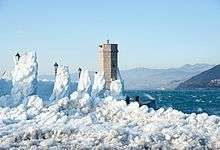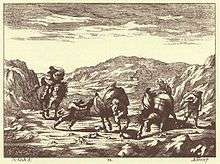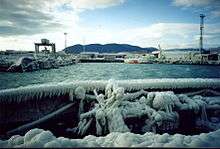Bora (wind)
.jpg)
The Bora (Bulgarian and Russian: бора, Croatian: bura/бура, Greek: μπόρα, Slovene: burja, Italian, Polish and Turkish also Venetian: buòra) is a northern to north-eastern katabatic wind in the Adriatic, Croatia, Montenegro, Italy, Bulgaria, Greece, Slovenia, Poland, Russia (Novorossiysk) and Turkey.
The same root is found in the name of the Greek mythological figure of Boreas/Βορέας, the North Wind. Historical linguists speculate that the name may derive from a Proto-Indo-European root *gworh- meaning "mountain" and giving rise to Germanic burg and berg.[1] A similar pattern is seen in the cognate name of the buran winds of central Asia and the name purga of their Siberian subtype.
In Greek, the word "bora" (μπόρα) describes an intense summer rain that lasts for a few minutes. In Croatian "burno" means "violently" and is commonly used to describe the weather.
Features

The changeable Bora can often be felt all over Montenegrin Littoral, Dalmatia, Istria, the Slovenian Littoral, Trieste, and the rest of the Adriatic east coast. It blows in gusts. The Bora is most common during the winter. It blows hardest, as the meteorologist Baron Ferdinand von Wrangel explained it by extending Julius Hann's explanation of Alpine katabatic winds to the north Adriatic,[2] when a polar high-pressure area sits over the snow-covered mountains of the interior plateau behind the Dinaric coastal mountain range and a calm low-pressure area lies further south over the warmer Adriatic. As the air grows even colder and thus denser at night, the Bora increases. Its initial temperature is so low that even with the warming occasioned by its descent it reaches the lowlands as a cold wind.[3] The wind takes two different traditional names depending on associated meteorological conditions: the "light bora" (Italian: Bora chiara) is Bora in the presence of clear skies, whereas clouds gathering on the hilltops and moving towards the seaside with rain or snow characterize the "dark bora" (Bora scura).
Areas hit


The area where some of the strongest bora winds occur is the Velebit mountain range in Croatia. This seaside mountain chain, spanning 145 kilometers, represents a huge weather and climatic divide between the sharp continental climate of the interior, characterized by significant day/night temperature differences throughout the year, and the Adriatic coast, with a Mediterranean climate. Bora occurs because these two divided masses tend to equalize. Sailing during the Bura can be challenging and it requires caution, regarding readiness of both the boat and its crew. Short, high waves with white crests are its characteristics, making the navigation difficult. The small drops formed by the wind create a so-called "sea smoke" that reduces the visibility significantly. Experienced seamen have a proverb: "When Bura sails, you don't!"[4] Sailing can be extremely dangerous for an unexperienced navigator in the Velebit channel because the wind can start suddenly on a clear and calm day and result in major problems, frequently also affecting road traffic. Near the towns of Senj, Stara Novalja, Karlobag and the southern portal of the Sveti Rok Tunnel in Croatia, it can reach speeds of up to 220 kilometers per hour. On 21 December 1998 the speed of a gust on the Maslenica Bridge (north of Zadar) was measured at a record speed of 248 kilometres per hour.[5] During 22 to 25 December 2003 on King Tomislav highway near Sveti Rok Tunnel new record was measured at speed of 304 kilometers per hour.[6]
In February 2012, during the Eastern European Cold Wave, the shoreline in Senj froze and snow piled up after a 150 km/h bora plummeted the temperature to -14 °C, with waves of 7 metres. The bora ripped the trees from the soil and destroyed roofs of houses.[7] On the island of Pag, the bora threw fish out of the sea. In many Croatian coastal cities, fresh water froze inside the pipes.[8]
The wind is also an integral feature of Slovenia's Vipava Valley and, to a lesser extent, the Karst Plateau (known as Carso in Italian), an area of limestone heights over the Gulf of Trieste stretching towards the Istrian peninsula. Because the region separates the lower Adriatic coast from the Julian Alps range, extreme bora winds often occur there. They have influenced the region's traditional lifestyle and architecture. Towns on the coast, where the bora frequently occurs, are built densely with narrow streets in part because of the wind. Buildings in several towns and villages in Slovenia and the Province of Trieste (Italy) have stones on their roofs to prevent the tiles from being blown off. Chains and ropes are occasionally stretched along the sidewalks in downtown Trieste, Italy, to facilitate pedestrian traffic — gusts in the city are usually above 120 km/h reaching to maxima of near 200 km/h. A strong bora will often be reported on Italian television news. Slovenian towns where the strongest bora occurs are Ajdovščina, Vipava and, to a lesser extent, Nova Gorica. In Slovenia, the most affected section is usually the upper part of the Vipava Valley, stretching from Ajdovščina to Podnanos, where the speed of the wind can exceed 200 km/h.[9]

Strong bora winds also occur in the Tsemes Bay of the Black Sea near the Russian port of Novorossiysk, where they are known as nordost ("northeastern").[10] They can reach speeds of up to 220 kilometres per hour.
In fiction
The Bora bursting out on the Venetian Lagoon is the setting for the cataclysmic end of Donna Leon's crime fiction novel A Sea of Troubles (2001). The protagonist, Commissario Guido Brunetti of the Venice police, must venture into the fierce storm in a frail police launch - a most foolhardy act - to try to catch a murderer and save a young woman for whom he cares deeply.
See also
Notes
- ↑ The Oxford introduction to Proto-Indo-European and the Proto-Indo-European World, J. P. Mallory, Douglas Q. Adams Oxford University Press, 2006 p121
- ↑ F. von Wrangel, "Die Ursachen der Bora in Noworossisk", Repertorium für Meteorologie 40 (1876:238-40); the Bora of the Karst was described by F. Seidel, "Bermerkungen über die Karstbora", ''M.Z. 8 (1891:232-35), noted by Julius (von) Hann, Handbook of Climatology Robert DeCourcy Ward, tr. (1903): see Petra Seibert, "Hann’s Thermodynamic Foehn In the Adriatic tradition, the Bora comes from three mouths: Trieste, Rijeka and Senj. Theory and its Presentation in Meteorological Textbooks in the Course of Time".
- ↑ v. Hann 1903.
- ↑ http://www.sailingeurope.com/en/yacht-charter-in/croatia/wind
- ↑ A. Bajić, B. Peroš, V. Vučetić, Z. Žibrat, Wind load - a meteorological basis for Croatian standards, GRAĐEVINAR 53 (2001), page 501, (in Croatian); http://hrcak.srce.hr/file/18613
- ↑ Novi list;http://novine.novilist.hr/default.asp?WCI=Rubrike&WCU=285A285F28632859285A2863285A28582858285B286328962897289E286328632860285C285A2859285828632863286328582863M
- ↑ http://www.index.hr/vijesti/clanak/pogledajte-kako-je-jucer-bilo-u-senju-bura-nosi-sve-pred-sobom-dize-cak-i-krovove/598037.aspx
- ↑ http://www.24sata.hr/news/karlobag-odsjecen-a-u-senju-bura-cupa-krovove-i-nosi-cigle-252881
- ↑ http://www.zurnal24.si/za-ajdovci-mirna-noc-pred-njimi-vetroven-dan-clanek-147460
- ↑ A book about bora
References
- Hann, Julius. (1903). Handbook of Climatology (Robert DeCourcy Ward, tr.). New York: MacMillan. OCLC 3592809
External links
| Wikisource has the text of the 1911 Encyclopædia Britannica article Bora. |
| Wikimedia Commons has media related to Bora (wind). |
- Local Mediterranean winds
- Name of Winds
- Il Libro della Bora (In Italian. Eng: The Book of Bora)
- Extreme Hurricane Force Bora - Croatia - March 05, 2015 on YouTube